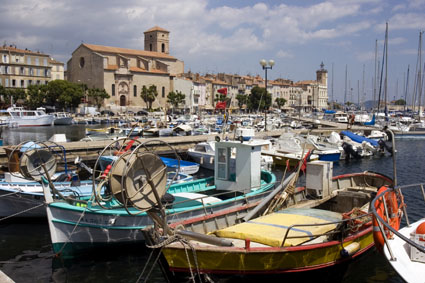La Ciotat
Department:
Bouches-du Rhône (13)
Region: Provence-Alpes-Côte-d'Azur
BIRTHPLACE OF FILM AND PÉTANQUE
Located on the coast, roughly mid-way between Marseille and Toulon, the commune of La Ciotat has much to boast about, other than its generally equable and rocky maritime setting, and artificial sandy beach.
The Parc du Mugel, on the Anse deu Petit Mugel, is classified as one of the Notable Gardens of France by the French Ministry of Culture. Sheltered by the massive rock called "Le Bec D'Aigle" (the Eagle's Beak), 155 meters high, it contains both a botanical garden of tropical plants and a nature preserve of native Provençal plants, covering the hillside below the rock.

©Atout France/Michel Angot
And while Cannes might host the famed film festival, La Ciotat was the setting of one of the very first projected motion pictures, L'Arrivée d'un train en gare de La Ciotat filmed by the Lumière brothers in 1895. After several private showings, the 50-second long film was given a public screening in Paris on 28th December, 1895, the first recorded commercial public showing of a motion picture. According to the Institut Lumière, before its Paris premiere, the film was shown to invited audiences in several French cities, including La Ciotat. It was screened at the Eden Theatre in September 1896, making that theatre one of the first motion picture theatres.
Another three of the earliest Lumière films, Partie de cartes, L'Arroseur arrosé (the first known filmed comedy), and Repas de bébé, were also filmed in La Ciotat in 1895, at the Villa du Clos des Plages, the summer residence of the Lumière Brothers. In 1904 the Lumiere Brothers also developed the world's first colour photographs in La Ciotat.
©Atout France/Emmanuel Valentin
Three years later, La Ciotat saw another first, the invention of pétanque, that France-wide pastime that also enjoys a running fugue with its predecessor, boules. Now it would be an insult for me, un Anglais, to attempt to explain the differences between boules and pétanque, so, for what follows, you can blame the late Peter Mayle. The essential difference seems to be that in boules there is a 'run-up' before your boule is cast into the air, while in pétanque, you start by standing within a circle with both feet together on the ground, which descends from les pieds tanqués. Inevitably, the two expressions become interchangeable in some parts of France; indeed, in my only exploit into the boules arena, in Lyon, I stood with my feet together, without a run-up. So that meant we were playing pétanque, although everyone called it boules. It, and I, were given new names when, by a series of flukes, I contrived to win.
According to Peter Mayle, the more stationary form of the game evolved when, in June 1910, one Jules Lenoir, no longer as nimble as he once was because of rheumatism, bemoaned his inability to play the game he enjoyed. So it was that his friend, Ernest Pitiot decided that they would play a shortened version of the game, that didn't involve to run-up. And the rest, they say, is history.
Recent Articles
-
French Food and Drink - No BS Guide for lovers of Food, Wine, Liqueurs
Aug 28, 19 03:18 AM
Our guide to French food and drink for those who love traditional French food along with our no BS guide to understanding French wine and liqueurs
-
Things To Do In Carcassonne The Ultimate Tourist Guide
Aug 24, 19 06:26 PM
The ultimate tourist guide to things to do in Carcassonne when you visit this wonderful town in Aude France. Discover the places to go and see in Carcassone.
-
Lyon Old Town Guide to Vieux Lyon
Aug 18, 19 07:48 AM
Your complete guide to Lyon old town otherwise known as the Vieux Lyon. Don't miss this amazing part of the city if you're visiting Lyon in France.
-
18 French Villages You Must Visit Most Beautiful Villages in France
Aug 17, 19 06:31 AM
Our guide to the 18 most beautiful French villages you simply must visit. Loads of info, photos and facts in our ultimate villages in France tourist guide
-
What a Pissoir - The True Story of France's Unique Urinals
Aug 13, 19 03:47 PM
Is there anything more French than a pissoir? Sadly on the decline nevertheless the pissor is an endring image of the country. This is their story





